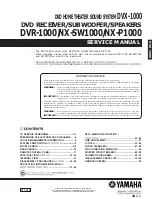
dV-DOSC dV-SUB Manual V3.0
June 2005
97
four dV-PIN25 (front first, rear last) to secure the bottom dV-DOSC to dV-BUMP. Verify the tilt angle
for the first enclosure and perform any required tilt adjustments using the rear screwjacks.
Note : Compensate for the 3.75 degree trapezoidal angle of dV-DOSC versus the actual site angle by using
a 3.75 degree angle between the rear of the bottom enclosure and dV-BUMP.
The next step is to connect two more dV-ANGLE bars to the rear locator slots of the bottom dV-
DOSC enclosure using two dV-PIN25. Pre-select the appropriate hole position to give the desired tilt
angle for the second enclosure.
Note: As a reference for dV-ANGLE bar orientation, the ball/tab of the angle bar should always be facing
outwards.
Place the second dV-DOSC on top of the bottom enclosure by mating the two front rigging posts on
the second enclosure and the dV-ANGLE bars that were previously mounted on the bottom
enclosure with the available locator slots. Attach the two front points using two dV-PIN25 to secure
the second dV-DOSC enclosure's front rigging tabs to the bottom enclosure. Tilt the rear of the
second enclosure if necessary and secure the rear points using two dV-PIN25.
The same procedure is followed for all subsequent dV-DOSC enclosures until stacking is completed.
The correct angle for the entire array is then obtained by fine adjustment of the V-DOSC bumper
screwjacks. Focus of the top enclosure can be checked by sight from behind the array - but you must
compensate for the 3.75 degree trapezoidal angle of dV-DOSC since the wavefront is radiated parallel
to the front of the cabinet (not perpendicular to the trap angle). As a sighting guide, attach a dV-
ANGLE bar with 3.75 degrees at the rear of the top enclosure and a second dV-ANGLE with 7.5
degrees at the front of the top enclosure. Visually lining up the tops of the two dV-ANGLE bars
provides a sighting guide that is perpendicular to the front of the top enclosure.
Looking from the rear of the array and sighting along the two dV-ANGLE bars, the tilt of the array
should be aligned so as to cover the rearmost seats of the audience. Alternatively, from the highest
section of audience area, if you can see the upper wall of the top dV-DOSC enclosure, you are 3.75
degrees out of the coverage pattern. More precise aiming can be accomplished by placing a laser
pointer or similar device on the upper wall of the top enclosure (and compensating for the 3.75
degree trap angle). A similar visual check should also be made with respect to the lower wall of the
bottom enclosure of the array to ensure that the closest members of the audience are covered.
Safety Rules
CAUTION: NO MORE THAN 12 dV-DOSC ENCLOSURES SHOULD BE STACKED ON ONE dV-
BUMP/V-DOSC BUMPER ASSEMBLY. INSTABILITY CAN OCCUR EITHER WHEN TILTING THE
ARRAY OR UNDER HARD WIND CONDITIONS.
FOR STABILITY REASONS, THE dV-DOSC ARRAY MUST BE PHYSICALLY CONTAINED WITHIN
THE VERTICAL FOOTPRINT OF THE V-DOSC BUMPER.
Always test the strength of the supporting floor - for 12 enclosures each screwjack can produce up to
a 95.5 kg load (210 lbs). If necessary, use plywood sheets or steel plates under individual screwjack
feet in order to help distribute the load.
Verify that all dV-DOSC enclosures are securely interconnected with dV-PIN25.
For improved stability in outdoor situations, ratchet strap the dV-BUMP and V-DOSC BUMPER
assembly to the stacking platform whenever possible.
Summary of Contents for dV-DOSC
Page 1: ...Version 3 0 June 2005 dV DOSC dV SUB OPERATOR MANUAL ...
Page 2: ......
Page 18: ...Figure 5 dV DOSC 3 way system configuration ...
Page 143: ...dV DOSC dV SUB Manual V3 0 June 2005 143 Figure 92 dV SUB Line Drawing ...
Page 146: ......
Page 147: ...dV DOSC dV SUB Manual V3 0 June 2005 147 ...
Page 148: ...dV DOSC dV SUB Manual V3 0 June 2005 148 ...
















































